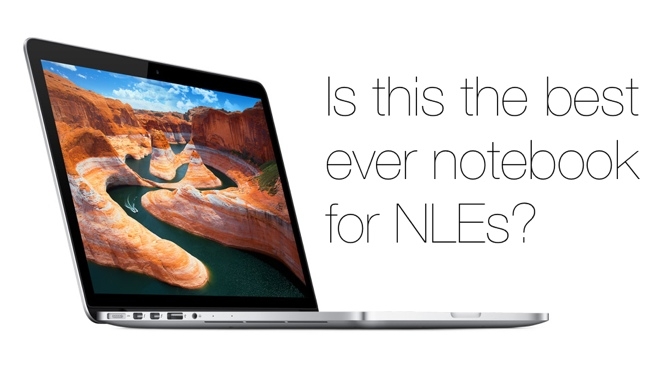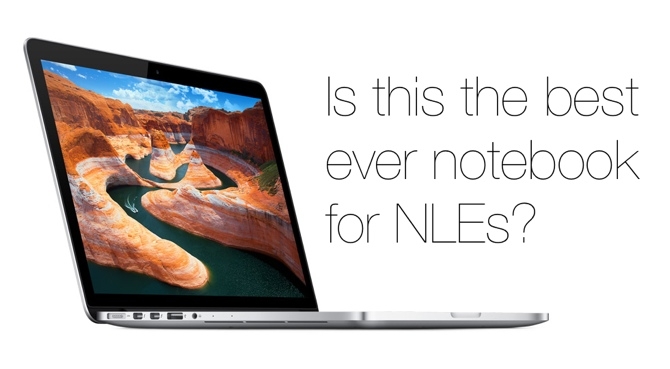
 Is this the best ever notebook for NLEs?
Is this the best ever notebook for NLEs?
Tuesday's announcements from Apple ranged far beyond the long mooted iPad mini and, for the content creation community, a stunning update for the all-in-one iMac desktop and a 13-inch Retina Macbook. K. Stewart reports.
As Apple's Phil Schiller remarked, the Bondi Blue iMac kicked off Apple's revival under Steve Jobs and is arguably the flagship of the Mac range - at least until the MacPro's hinted-at reboot in 2013.
As of last night, it had been 539 days since the last iMac update - well beyond the near-annual update average and particularly agonising for those waiting on Ivy Bridge processors and USB 3.
Thinner iMacs
So what has the iMac 2012’s protracted development brought us? Retina-quality screens would've been nice, but were never a realistic expectation in 2012 - not just for the size and cost of the screens, but the sheer horsepower required from the CPU/GPU to drive such a vast pixel array.
Instead, the signature feature of the 2012 iMac is thinness - a startling 80% reduction over the previous model. Aside from the simple aesthetics of this change, the remodelling provides a superior 'painted on' display and 75% less reflections.
There’s also an option for something Apple call a Fusion Drive, which offers 128GB of flash storage with a standard 1TB or 3TB hard drive and of course built-in OS X support for user-friendly operation.. The idea of running your NLE application off the Flash drive and pulling footage from the HDD is certainly intriguing. The previous model introduced the ultra high-speed Thunderbolt I/O technology which is slowly gaining some traction with peripheral makers, so overall a properly configured iMac is a serious production tool.
Goodbye to Optical Drives
On the negative side, there have been some casualties in the pursuit of a supermodel silhouette. Predictably, the optical drive has gone (there’s an external option) and while the 27-inch model supports an easy RAM upgrade, the 21.5-inch model requires a degree of disassembly - an unwelcome change over the previous model. Before perusing the options, be aware upgrading the storage on an iMac is not for the faint-hearted. Choose wisely.
The entry-level 21.5-inch model starts at £1,099 (inc. VAT) for a 2.7Ghz Intel Core i5 and 8GB of 1600MHz DDR3 memory (but can be configured up to 16GB) and a 1TB (5400-rpm) hard drive as standard. The 27-inch iMac starts at £1,499 for a 2.9Ghz quad-core Intel Core i5, 8GB memory (configurable up to 32GB) and 1TB (7200-rpm) hard drive as standard. There are plenty of additional options to get the iMac you want and it’s important to get these right at the time of purchase.
Ivy Bridge for the Mac Mini
Also upgraded to Ivy Bridge is the Mac Mini, starting at just £499 and now twice as powerful as the previous model. There are two base models, plus a server version, and Thunderbolt I/O on all three. The i7 model even has a Fusion Drive option. These are compact, robust and highly reliable machines which shouldn’t be ignored but...
13" Retina Macbook Pro
They’re never going to get more attention than Apple’s first 13” Retina MacBook Pro. Tim Cook called the 15-inch version the finest Mac ever produced by Apple and a vision of the future of notebooks. The latter is a key point as the price tag on the Retina screen and flash only storage meant it exists alongside rather than replacing the non-Retina MacBook Pro range.
The new Retina 13-inch has a native 2560 x 1600 resolution display with a default resolution of 1280 x 800. The appeal of editing video on such a high quality screen is obvious, however the 13-inch model lacks the discrete graphics and quad-core CPU of the 15-inch model. Pricing starts at £1499 for a 2.5Ghz dual-core Intel Core i5 with integrated Intel HD Graphics 4000, 8GB Memory and 128GB flash storage (configurable up to 768GB for £1050!).
A surprise new iPad
Keeping with the Retina theme, one of the keynote’s most notable surprises was a 4th generation iPad. There had been rumours of a tweaked new iPad with a Lightning connector like the iPhone 5, but a full-blown new model just 230 days after the new iPad’s debut was a real surprise. The Apple-designed A6X chip which debuted in iPhone 5 has been immediately pressed into service with the new iPad, offering up to twice the CPU and GPU performance of the previous version. Given that while the Retina screen wowed most critics, the GPU sometimes struggled to keep up (some new iPad games ran slower or offered less graphical effects compared to lower resolution iPad 2 versions) this should deliver an appreciable benefit. The front facing camera has also been upgraded, while Wi-FI performance is doubled and the cellular model benefits from support for additional LTE carriers worldwide. The external design of the iPad is unchanged, as is pricing (starting at £399 for 16GB WIFI-only), so this is a straight replacement for the previous model while iPad 2 remains in the line-up as the entry-level model.
Apple’s thinking behind 4th generation iPad is simply to keep ‘the foot on the gas’ - an understandable decision given Tim Cook revealing iPad sales had now surpassed 100 million worldwide. Whether it’s enough to retain Apple’s existing overwhelming market share remains to be seen with Windows RT tablets shipping October 26th and Google rumoured to be revealing a 10” Nexus tablet on October 29th.
The big Mini announcement
The new tip of the spear against low-end competitors is, of course, iPad mini. There were few surprises that hadn't leaked from Apple's supply chain, but the keynote presentation somehow made the predictable fresh and desirable. Apple's case for iPad mini revolved around comparisons. The resolution is the same as iPad 2, but it offers better cameras, better wifi, a lightning connection. But the real edge came in the comparison with a Nexus 7-inch model. Apple’s iPad mini has a 7-9 inch screen which actually provides a third larger display area and for portrait web-browsing a claimed 50% bigger web view. Sharpening the attack further was a display of underwhelming Android tablet apps with those tailored to the iPad's screen. The difference was eye-opening, but then again so was the pricing.
For us or for them?
There's always been a dichotomy at the heart of Apple, between a user-experience aimed 'at the rest of the us' and Mercedes-class industrial design. At £269 for the entry-level iPad mini there's a considerable premium over the £190 Nexus 7. So, the 'pricing umbrella' for non-Apple 7 inch tablets won't be removed this year but it would be a brave person to bet against long queues and shortages.
And returning to the NLE audience, if you've been looking for a slightly smaller, slightly more affordable iDevice to use with all those iPad professional apps pre-orders open on Friday 26th for the wifi-only models. Smartphones may be the most lucrative and competitive technology market today, but for the future of general purpose computing tablets are the leading edge and the next few months are going to be fascinating.
Tags: Technology



Comments